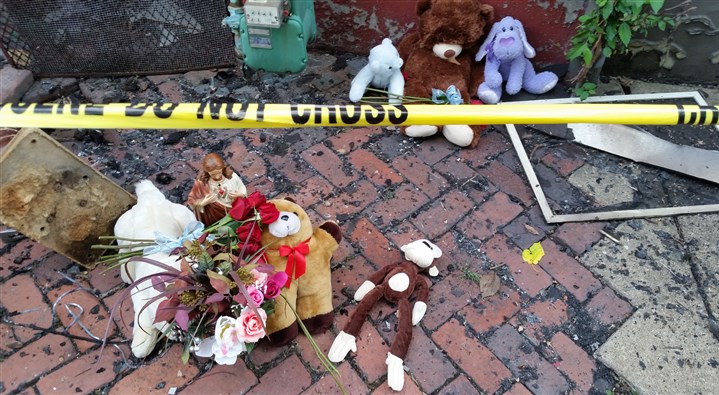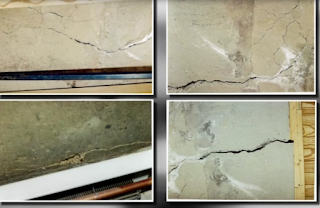Marshall-Shadeland fire claims lives of 2 brothers July 25, 2016 5:59 PM

Andrew Goldstein/Post-Gazette
A makeshift memorial outside the house in Marshall-Shadeland where two boys died in a fire.
By Torsten Ove and Finnegan Schick / Pittsburgh Post-Gazette
As flames roared and smoke billowed from a Marshall-Shadeland home Monday morning, neighbors and passers-by scrambled to get a family with several young children out of the residence before it was too late.
Some tried kicking in the locked front door. Others tried smashing through the back door. Even once they got in, the intense heat and thick smoke turned them away.
“It was pitch black, smoky,” said neighbor David Jones, 19, who went in through the back door but couldn’t get far. “You couldn’t see anything. I could barely make it through the kitchen.”
Despite their efforts, two boys, identified as brothers Dylan, 7, and Nicholas Taylor, 12, died in the fast-moving blaze that trapped them on the third floor of their Sorrell Street home. Their mother, identified by neighbors as Jennifer Taylor, 38, and 6-year-old brother survived after she grabbed the boy and jumped out of a second-story window, authorities said. They were being treated at UPMC Mercy.
Outside the hospital, an emotional scene unfolded Monday afternoon as family members consoled each other and tried to come to grips with the loss.
Raymond Taylor, the boys’ father, grieved outside the emergency room. In shouts and tears, Mr. Taylor tried to explain the situation to his other children. He called Dylan and Nicholas his “angels.”
Ebony Pugh, spokeswoman for Pittsburgh Public Schools, said the district was notified that Dylan and Nicholas had died.
Dylan had been a first-grader at Whittier K-5 in Duquesne Heights. Nicholas was a sixth-grader at Pittsburgh South Hills 6-8 in Beechview.
“Our thoughts are with the family at this time,” Ms. Pugh said, adding that the district hoped for a speedy recovery for the Taylors’ injured relatives.
The cause of the fire was being investigated by the city arson squad.
Firefighters received the first call for the blaze at 10:25 a.m. on Sorrell Street.
But before they arrived, neighbors and passers-by saw the smoke and got to work.
Two brothers from Mt. Lebanon, Bronson and Colton Zoller, said they were driving to visit a friend when they saw the blaze. They said they pulled a U-turn and ran to the house.
Bronson, 19, said the front door was locked. They tried to get in through the back, couldn’t and returned to the front. By then, they said, someone had kicked in the front door. The brothers said they ran inside but were unable to see anything or do much to help because of the smoke and flames were too intense.
Describing the scene to the media, Bronson said, “I can’t breathe. I can’t see my hand in front of my face.”
After hours at the scene in 90-degree heat, exhausted firefighters finally took down their tape and cleared the street. Two firefighters were injured; one was treated for heat exhaustion and another hurt his shoulder.
Overall, it was a taxing day for firefighters.
“It was a very sad day,” said Shamus Cringle, a battalion chief with the city’s bureau of fire, one of the 40-plus firefighters who responded to the scene. “You just have to do your job. We all deal with it in different ways. It isn’t easy.”
As firefighters packed their gear and rolled away, one neighbor walked up to them and said quietly, “Thank you. Thank you for all you do.”
A makeshift memorial composed of stuffed animals and flowers had appeared on the sidewalk in front of the residence by Monday evening.
Neighbor Jane Griffiths stopped by to take a look at the burned-out home around 8 p.m. She said her grandchildren had often played with the Taylor boys who died in the fire.
“They’d ride bikes. They’d come in my daughter’s yard and play on the swings, play backyard basketball,” she said. “[My grandsons] were so excited because there were boys in the neighborhood to play with.”
Post-Gazette reporters Jonathan D. Silver, Anthony Conroy and Andrew Goldstein contributed to this story. Torsten Ove: tove@post-gazette.com. Finnegan Schick: fschick@post-gazette.com.
First Published July 25, 2016 11:21 AM


























































